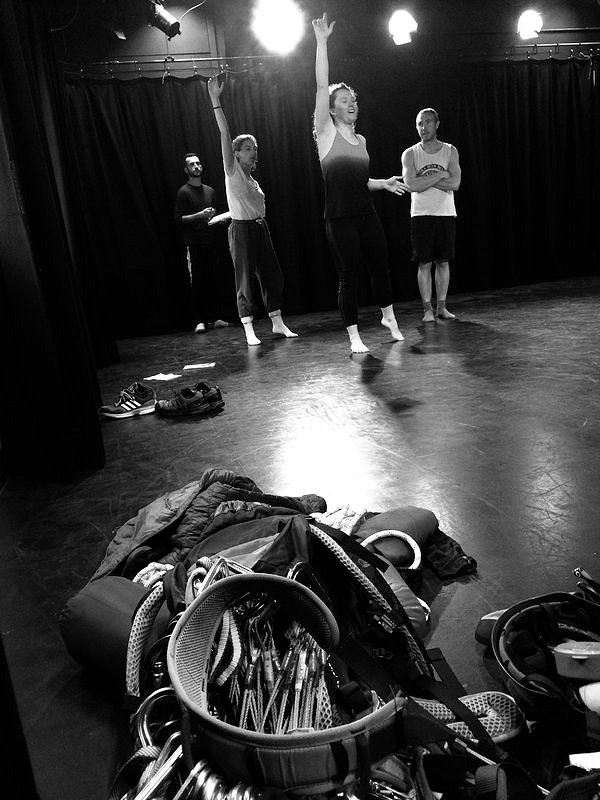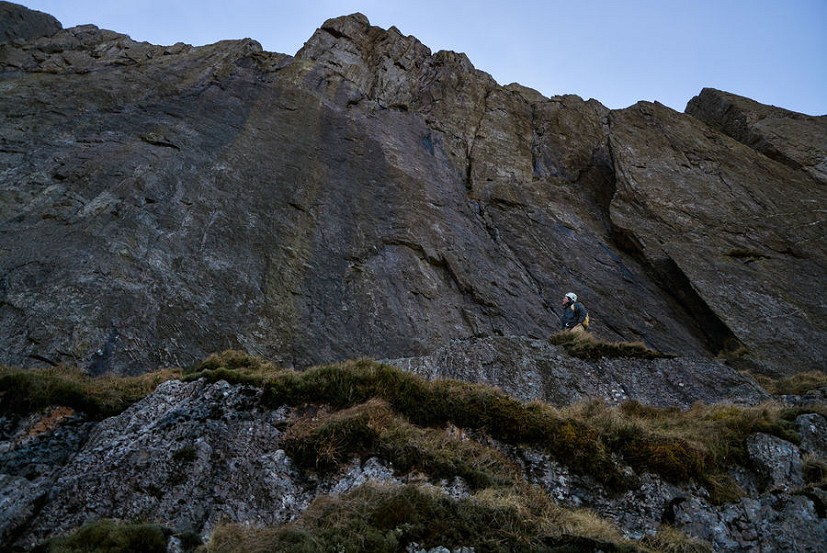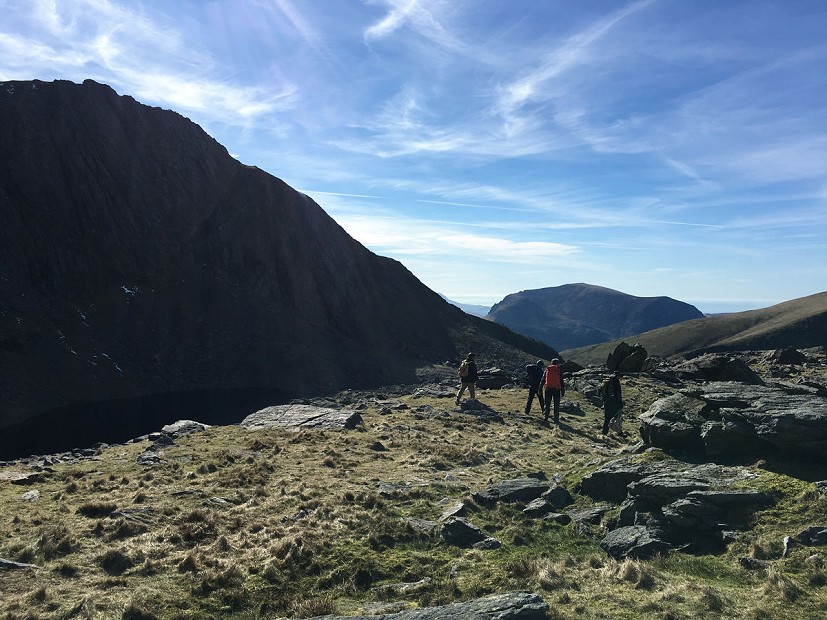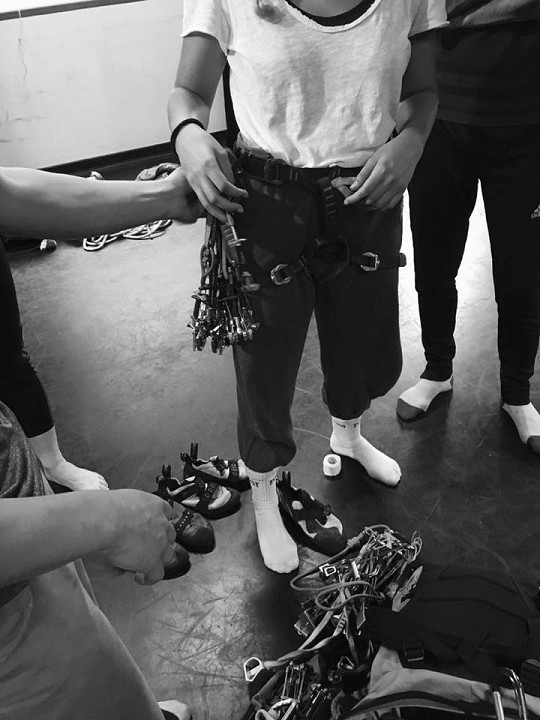
Johnny Dawes' historic first ascent of Indian Face (E9 6c) E9 6c in October 1986 was widely regarded as a new benchmark in climbing and subsequent ascents have been duly captured by filmmakers and photographers alike. This November, however, his ascent and the line itself will be enacted in a different, more theatrical medium: enter stage left, Johnny Dawes. University of Leeds academics Jonathan Pitches, Professor of Theatre and Performance and David Shearing, Artist and Practitioner-researcher have created a performance titled Black Rock, a live multimedia installation dedicated to Clogwyn D'ur Arddu and to Dawes' feats in North Wales. Dancers, digital lighting and music will mix with projections and storytelling to evoke the emotion and history surrounding the route.
The performance is the pinnacle - or a subsidiary peak, perhaps - of a long-term project called Performing Mountains, led by Jonathan, in which climbers, artists and academics collaborate to discuss the points at which climbing and artistic performance converge. Whilst Johnny doesn't appear in person, recorded stories and interpretations of the line will attempt to share his insight and charisma. To find out more about this ambitious creative endeavour, we spoke to Jonathan and David.
'There was something special about that shallow scoop on Clog. It was just the right angle to grill your resolve slowly, had rests to allow doubt to seep into a mind that hangs on too hard. The line is a faint groove with side holds that don't allow strength to have its head. Pull hard and your feet are more likely to scud off. It's too long to have sticky boots all the way. Tie them too tight and your feet will stop telling your brain what is going on down there at the business end. Above all the parameters is its sheer quality. It has the essence of the great materials. Oak, whales, the layout of stars. Hang on tight and stay awake, and alive, and like passing through the metre thick rings of Saturn the scale runs through you, sieving off remnants of the mundane and leaving a new colour that has no physical counterpoint.' - Johnny writing about Indian Face in a UKC article.
How did you come to be interested in the performative aspects of climbing? Are you climbers yourselves?
JP: We became interested in climbing through different routes – but neither of us have a climbing background, nor would we consider ourselves climbers now! I have been walking up mountains in the Lake District now for a dozen years, (and have only 20 Wainwrights left to go). This has given me a good feeling for how diverse the landscapes of mountains are, even within one National Park, and a growing fascination for the many different characters who inhabit mountains.
For David, it's been a bit of a baptism of fire (or of rock!). He's more of a city-dweller but has made award-winning artworks about the environment and particularly about the weather which puts him in a really interesting place to consider how to translate the experience of climbing to an audience on the ground. In a sense, we're both outsiders – at least to the rock climbing and mountaineering community - and perhaps able then to reflect it in new and unexpected ways.
DS: I think being an outsider offers us a different perspective, our aim is to bring audiences together, to discover what is shared between us and what climbing can do to inspire us to consider other ways of being in the world, with nature and rock.
What are the 'shared languages' between climbing and performing that you mention?
JP: This has been a fascinating aspect of the project I am leading. It's called: Performing Mountains and has several strands to it. In the public seminars we have been holding between prominent mountaineers and climbers on the one hand and artists and academics on the other, we have found lots of cross-overs: approaches to training, the enjoyment of risk, the sensitivity to environment, the appreciation of the aesthetics of a climbing line or, for that matter, of a mountain as whole. Lots of that crossover will be reflected in the performance piece we are making, Black Rock. I'm pretty confident that this will be the first ever live multimedia installation dedicated to Clogwyn D'ur Arddu and to Johnny Dawes' amazing feats there and around the slate quarries in Snowdonia.
DS: We have been working with climbers and dancers in the studio to explore how the body moves when climbing, uncovering where the pressure and tension points are, how a climber might best use their legs and the intricate precision in the fingertips and toes. What has struck me is how climbers often talk of the beauty of particular climbs, which appears as a type of flow in the moment, this shares many characteristics with choreographic practice.
How far is it true to say that climbing is a form of performance and can learn from the languages of theatre and performance studies?
JP: I think this is the $64M question! I'm trying to make sense of this in a book I am writing about mountains, theatre and performance, which is also part of the project. But speaking in less than 80,000 words, I think there are really interesting dimensions to climbing which might be articulated in the language of theatre. As I see it from outside, climbing is all about training, about imagining ahead of the game what you will encounter, about rehearsing a route, with real dedication, sometimes for months or even years and it's clearly about improvising when you can't control what's ahead of you. That's a really theatrical mindset, to my mind. Add to that the creativity of naming routes, the amazing skills of movement on show – with the rock as choreographer as Dawes once said - and the ever-growing spectatorship which surrounds the liveness of climbing (indoors and out) and you've got a strong argument to call climbing a kind of performance.
Tell us a bit about the format of Black Rock - is there dance, music, reading? What can we expect to see?
DS: Black Rock takes the form of a multimedia environment that you enter into. We want to bring the audience into the world of climbing. Expect video projection, light, sound, haze, wind, water and rock. We are working with a team of artists, I'm leading on the design and direction but the piece will also have a newly commissioned 16-channel sound-score by James Bulley and poetic text written by Claire Carter who have directly responded to the site. We also have some digital lighting developed by Invisible Flock and we have two dancers choreographed by Carlos Pons Guerra. Climbing is multisensory, the whole body engages in a climb and we want to create something that appeals to that sensibility.
How did you choose whom and what to portray in the production? Why Johnny, and why Indian Face?
JP: The project was born when Kendal Mountain Festival approached me with the mad idea of celebrating the Indian Face first ascent and at the time I hadn't even heard of Johnny Dawes, topos, or E9 6Cs. But I saw the germ of an idea and after that meeting made the performance the centrepiece of a research project I was already conceiving, which ultimately was funded by the Arts and Humanities Research Council. This was to investigate who performs on mountains and how mountains themselves might be understood as performers – or at least agents of experience. After researching the original climb, and building a great working relationship with Johnny himself, it became clear to me that his Indian Face FA has such a legendary reputation for its audacity and beauty that it was a natural choice for translating into performance.
How receptive was Johnny to your ideas?
JP: As you will know Johnny is such a performer himself, as well as a poet, dancer and an acrobat, so he was always really interested in the project – in fact he had already thought about making his own performance under Cloggy – with Stravinsky and Helium balloons - well before we came on board!

DP: It must be strange to have one of your climbs explored as part of a performance, but Johnny is very understanding of the challenges and difficulties we face. It has been a fascinating process as each time we talk we slowly reveal hidden depths, going beyond the surface into philosophies, insecurities, empathy and the very nature of being alive.
Will there be a different response from climbers and non-climbers, do you think? You could argue that climbers are stereotypically a bit pragmatic and perhaps more scientific in their view of climbing. How would you persuade a theatre/arts cynic to come along?
JP: That's a great question. I might say something different to David on this but from my perspective climbers will get glimpses of what they know and are familiar with but be stretched to see the mountains differently and definitely not just a playground of new and legendary routes. There are lots of ways into the Black Rock piece, so there's no one saying 'this is how you will need to respond' but close-up experiences are what many of us are after nowadays and this will definitely deliver on that.
DS: Yes, we have met some rather pragmatic climbers but also those same climbers have been willing to try things and are not afraid to embrace their bodies. I think this makes a good match for an experiential piece. This isn't audience participation, but we do hope to take people on a journey, to question what it means to be a path maker and to find new connections with our surrounding. We hope to offer insights to both climbers and non-climbers alike. After all, there are multiple ways to climb a mountain.
Are you keen to do similar productions in future with other stories and climbers?
DS: We have already built some strong connections with KMF who have opened up new avenues and introduced us to a new context. There are some incredible stories and many marginalised and unpresented voices in outdoor culture; there is certainly more to explore here. For now, we're just learning the ropes.
- INTERVIEW: Albert Ok - The Speed Climbing Coach with a Global Athlete Team 17 Apr
- SKILLS: Top 10 Tips for Making the Move from Indoor to Outdoor Bouldering 24 Jan
- ARTICLE: International Mountain Day 2023 - Mountains & Climate Science at COP28 11 Dec, 2023
- ARTICLE: Did Downclimbing Apes help Evolve our Ultra-Mobile Human Arms? 5 Dec, 2023
- ARTICLE: Dàna - Scotland's Wild Places: Scottish Climbing on the BBC 10 Nov, 2023
- INTERVIEW: Loki's Mischief: Leo Houlding on his Return to Mount Asgard 23 Oct, 2023
- INTERVIEW: BMC CEO Paul Davies on GB Climbing 24 Aug, 2023
- ARTICLE: Paris 2024 Olympic Games: Sport Climbing Qualification and Scoring Explainer 26 Jul, 2023
- INTERVIEW: Malcolm Bass on Life after Stroke 8 Jun, 2023
- ARTICLE: Alexandr Zakolodniy - A Climbing Hero of Ukraine 26 Apr, 2023
















Comments